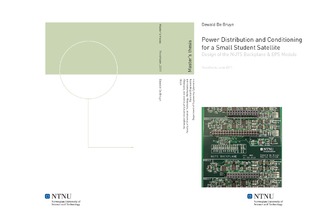| dc.description.abstract | The NTNU Test Satellite project aims to launch a 10x10x20 cm nanosatellite, weighing less than 2.66 kg. The satellite, which follows the CubeSat standard, is a relatively low cost project, and explores the use of comercially available, low cost electronic components in space. This work is mainly concerned with power management and distribution for NUTS, but also describes the design of a system backplane.The thesis is split into two parts. The first describes the design and evaluation of the backplane with main focus on power distribution, and the second part describes battery charging and power conversion in the Electrical Power System (EPS) unit.The backplane has been designed with flexibility, fault-tolerance and simplicity in mind. The design is based on a single I2C bus with bus repeaters for each sub-module, with the ability to isolate individual modules from the system in case of a malfunction. Power is distributed with dual 3.3V and dual 5V buses working in active redundancy, ensuring continued operation should a voltage converter fail. Power distribution for each module consists of three parts: power supply or-ing, current-limit switch and power monitor, and is integrated into the backplane. The state of the power switches and bus repeaters are controlled from two master modules, and a watchdog timer ensures return to a default state should both master modules be disabled. The proposed solution integrates all the management logic and power distribution circuitry into the backplane itself, leaving the valuable PCB space on the sub-modules free for module implementations. The power distribution unit has been evaluated with a separate prototype, and displays good performance in terms of power losses and response to over-current conditions. A prototype implementation of the backplane has been produced.The electrical power system of the satellite consists of solar panels, batteries, and voltage converters. With very limited power available, the main focus of the design has been to reduce losses in power conversion. A battery charge regulator (BCR) has therefore been proposed, which charges the battery while keeping the solar panels at their maximum operating point. This integrates a Maximum Power Point Tracking stage with a battery charger into a single converter, greatly increasing efficiency. Redundancy can be achieved by using separate converters for separate panels in parallel. A prototype BCR has been tested, and initial results show over 91% converter efficiency. | nb_NO |

